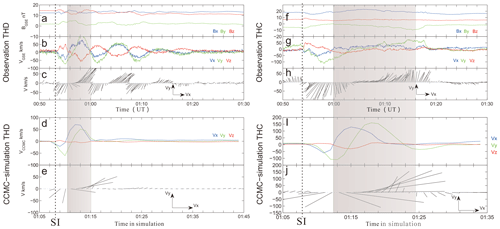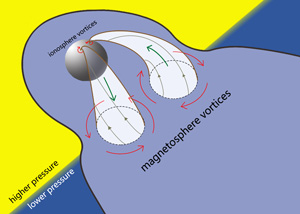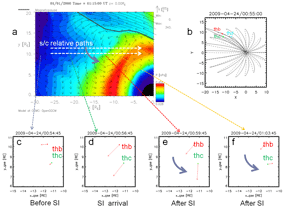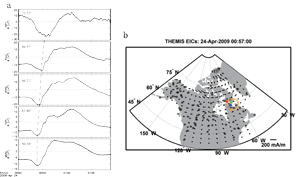
2014 THEMIS SCIENCE NUGGETS
THEMIS observed magnetospheric vortices driven by solar wind pressure pulse
by Quanqi Shi and Michael Hartinger
Introduction
Flow vortices are common in ordinary fluids. In a plasma, they also exist but their structure and evolution are complicated by the presence of electric and magnetic fields. Plasma vortices can transport plasma across boundaries. They can also generate electric currents along magnetic field lines and contribute to the aurora, which we can see on the ground.
Inside the Earth's ionosphere, the vortex observations are made remotely with radar or are indirectly deduced from ground magnetometers (based on the fact that the electric current in the ionosphere will change the magnetic field on the ground). Theories/models have predicted that solar wind dynamic pressure enhancements excite plasma vortices inside the magnetosphere that couple to the ionosphere. This scenario has also been supported by numerical simulations. However, there are no clear in-situ observations of such vortices attributed to solar wind pressure enhancements either in the dayside or nightside plasma sheet. Does this predicted vortex exist? Here we report the first in situ observation of such vortices in the nightside plasma sheet attributed to solar wind dynamic pressure pulses using coordinated observations of multiple THEMIS satellites. Global MHD simulations and ground magnetometer measurements are also used to study this vortex.
| Figure 1. THEMIS observations of the magnetotail response to the solar wind pressure pulse and global MHD simulation results. The time corresponding to the vortex passage is illustrated in the shaded region. The vertical lines indicate the SI start time/solar wind dynamic pressure pulse arrival time. The shaded areas correspond to the vortex proper, while the time between the SI start time (vertical lines) and the shaded area indicates a tailward flow response after the lateral compression of the magnetosphere by the solar wind dynamic pressure enhancement. |
Results
On 24 April 2009, the Wind satellite in the solar wind detected an interplanetary shock with a dynamic pressure increase. In response, THEMIS B, C, and D in the dusk magnetotail observed magnetic field and ion velocity perturbations after the sudden compression of the magnetosphere (which is called a sudden impulse, SI) when the shock passed. The velocity vectors versus time are consistent with motion through a typical vortex and also consistent with numerical simulation results. The vortex was followed at THD’s position by field line oscillations, which was a standing Alfvén wave consistent with a field line resonance (FLR) probably induced by the vortex. The vortex continued moving tailward and was later observed by THB and THC which were 4 RE away from THD. These two satellites (THB and THC) were separated mostly along Y by about 1.5 RE and the flow vectors they observed further confirm a vortex crossing, which is mainly consistent with previous models. From simulations and observations we also notice that the vortex is deep inside the magnetosphere, rather than simply near the magnetopause, which is a little different with models. It appears that the size of the vortex is growing while propagating tailward. Ground station measurements also found that this vortex coupled to the ionosphere.
| Figure 2. Animated model simulation of the plasma vortex. |
| Figure 3. Artistic rendition of the solar wind pressure wave and resulting plasma vortices that connec to the Earth's north magnetic pole. |
| Figure 4. Comparison of vortex perturbations corresponding to rotation as observed by THEMIS B and C with MHD simulation results. (a) The global MHD simulation results are shown for the duskside. The background color indicates plasma pressure and the arrows represent the plasma velocities. (b) THEMIS probe positions for satellite B, C and D. (c-d) Plasma velocity vectors observed by THEMIS B and C at different moments. Before the SI, we find that the flow vectors observed by THB and THC are very small. Upon arrival of the SI, we find tailward flows from both THB and THC, consistent with a lateral compression of the magnetopause. Several minutes later, the flow vectors at THB and THC become quite different from each other, and the sense of rotation is consistent with counterclockwise motion, as seen in the simulation and as expected from the Sibeck [1990] model. Therefore, from simulation and multi-point observations, we confirm that this is a tailward moving vortex that is caused by magnetospheric compression by the solar wind dynamic pressure enhancement. |
| Figure 5. Left plot shows horizontal component of the transient magnetic variation recorded at stations near the foot points of THEMIS B, C and D. Right plot shows equivalent ionospheric currents (EICs). The stars indicate the ground stations and the solid circles indicate the footpoints of THEMIS B (red), C (green) and D (cyan). The vectors indicate the current direction and intensity. A single vortex with counterclockwise rotation is seen near the ionospheric footpoints of THEMIS B, C and D, as demarcated by a yellow circled area. The sense of rotation of the equivalent ionospheric Hall current has a divergence that is consistent with an upward field aligned current (FAC) from current continuity, consistent with the FAC generation by the magnetospheric flow vortex we observed in the magnetotail. |
Conclusion
We report in-situ and ground observations of a solar wind dynamic pressure enhancement - induced vortex in the nightside plasma sheet and reproduce the in situ signature using global MHD simulations. Simulation and observations consistently show a vortex driven by a sudden impulse in the solar wind and extending deep inside the magnetosphere, not only near the magnetopause. The depth of penetration of the vortex into the tail (and the excitation of field line resonance) indicates that the energy coupling between the solar wind and the magnetosphere/ionosphere is significant.
Reference
Q. Q. Shi, M.D. Hartinger, V. Angelopoulos, A.M. Tian, S.Y. Fu, Q.-G. Zong, J. M. Weygand, J. Raeder, Z.Y. Pu, X.Z. Zhou, M.W. Dunlop, W.L. Liu, H. Zhang, Z.H. Yao, and X.C. Shen (2014), Solar wind pressure pulse-driven magnetospheric vortices and their global consequences, J. Geophys. Res. Space Physics, 119, doi:10.1002/2013JA019551.Biographical Note
Quanqi Shi is on the faculty of the Space Sciences Institute, Shandong University, China. His current research involves studying the solar wind-magnetosphere interaction (see http://space.wh.sdu.edu.cn/bencandy.php?fid=36&aid=561 for more information). M.D. Hartinger is a postdoctoral research fellow at the University of Michigan studying Ultra Low Frequency waves.
 Please send comments/suggestions to
Emmanuel Masongsong / emasongsong @ igpp.ucla.edu
Please send comments/suggestions to
Emmanuel Masongsong / emasongsong @ igpp.ucla.edu





